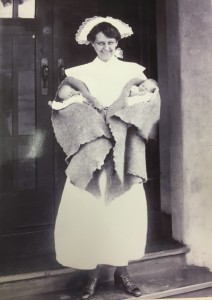The 1912 the Commonwealth-funded Maternity Allowance Act gave a financial payment of five pounds to all European women following the birth of a child (Indigenous and women of other ethnicities were not entitled to the payment). This demonstrates that the government initiative was aimed at reducing infant mortality and only increasing the white population of Australia. The payment was considered a radical measure as it was paid directly to both married and unmarried mothers, therefore it undermined the traditional patriarchal role of the husband. The payment was considered a large amount of money, the equivalent to two weeks wages for a man and five weeks wages for a woman, and paying the money directly to the women was to ensure that it was used specifically for the welfare of the woman and the child. This payment enabled the woman to pay for skilled birth attendants.
Thus, the early 20th century became a period of intense competition between midwives and doctors. An editorial in the Medical Journal of Australia claimed that the lavish payment would lead to women being lured by the “midwife, keen as any shark in the cities” at the prospect of making money out of the birthing women and that the consequences would mean an increase in puerperal fever. Some women did use the money to pay for a midwife to provide care during birth, either at home or in a midwifery run lying in home. However, increased regulation in lying in homes and pressure from the medical profession led many midwifery-run lying in homes to close, leaving women few choices of birth attendant and place of birth.
Although there was a large increase in doctor attended births in institutions, there was no significant corresponding reduction in maternal mortality. Approximately one woman in 200 died in from puerperal fever in 1912, and a decade later the number remained the same. Despite the lack of evidence and contrary to the actual statistics, independent midwives remained the scapegoat for maternal and infant deaths. Independent midwifery was in serious decline by the early to mid-20th century. The establishment of publicly funded maternity hospitals in Australia was a crucial obstacle to autonomous midwifery practice. The medicalisation of birth and medical dominance within the hospitals, led to the state and medical control of the training and regulation of midwives. Once women began to birth in hospital, the specialisation of obstetrics completed the medical dominance of birth. With the centralisation of maternity services into the bigger hospitals under medical direction, the smaller nursing homes and smaller hospitals began to close.
Profiles
NFSA. [NFSA Films]. (2014, May 12). Matron Shaw Guardian Angel To 100,000 Babies. Australian Diary 34.

Edna Shaw
© Paula Medway
Matron Edna Shaw {Sydney NSW, 1891-1974}
Edna Mary Anna Jane Shaw was born on 7 June 1891 at Murrumburrah, New South Wales. She undertook nursing training at the Marrickville Cottage Hospital in 1914-1917, and obtained her midwifery certificate from the Royal Hospital for Women, Paddington, in June 1918. She obtained her mothercraft certificate in 1927 from the Tresillian Mothercraft Training School, Petersham, run by the Royal Society for the Welfare of Mothers and Babies.
Edna was appointed acting Matron of Crown Street Women’s Hospital for a month in January 1919, and stayed on as deputy Matron under new Matron Agnes Clarke, taking charge of the district nursing. She also took charge of the new outpatient department in 1924, and the new premature babies ward in 1928. She was appointed Matron of Crown Street in 1936.
Matron Shaw was said to visit every mother and baby daily, provide clinical care where needed, instruct the nursing and midwifery staff, inspect the kitchen, laundry and staff quarters, and tend to the running of the hospital such as stoking the furnace, answering the switchboard, cooking, or even scrubbing floors.
Matron Shaw believed in rooming in (keeping mothers and babies together on the ward) and early discharge to home. While she embraced scientific advances to promote safer childbirth, she maintained that love and common sense remained essential.
Tall and serene, Matron Shaw had large, sparkling, blue-grey eyes and a warm smile. Known as ‘the mother of 100,000 babies’, she was loved far and wide and was highly respected by her staff. She was appointed O.B.E. in June 1950 and, on retiring on 31 October 1952, was presented with a cheque for £1000, following a public appeal. A new wing of the nurses’ home was named in her honour.
Edna Shaw died on 25 January 1974 and is buried in Waverley cemetery.
Read more at Australian Dictionary of Biography
